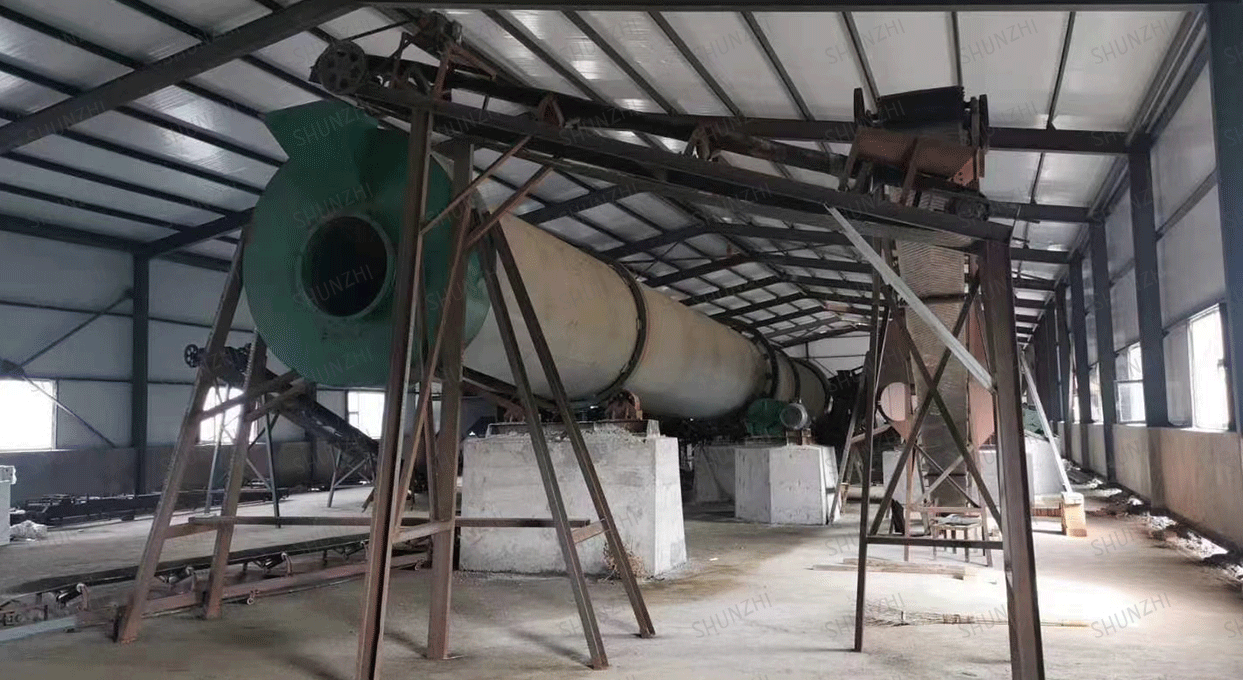Korea Compound Fertilizer Production Line
Korea Compound Fertilizer Production Line
Raw materials: corrosive acid, silicon powder, urea, ammonium nitrate, ammonium chloride, ammonium sulfate, ammonium phosphate (monoammonium phosphate, diammonium phosphate, heavy calcium, common calcium), potassium chloride (potassium sulfate) and other raw materials are prepared in proportion (Mainly based on local market demand and local soil test results, depending on which element is missing)
Compound fertilizer production process:Raw material metering, raw material crushing, granulation, drying, cooling, screening, film coating, packaging

The production process of compound fertilizer:
1. The mixing process of raw materials: The operator adds N, P, K, additives and other raw materials to the electronic belt scale in strict accordance with the requirements of the technicians on the amount of each raw material added. And the material flow should be uniform and sometimes uninterrupted operation. Otherwise, it will affect the measurement accuracy and the control of the granulation process, and affect the product content.
2. Crushing process of compound fertilizer raw materials: The metered raw materials flow into the feed port of the pulverizer, and the high-speed operation of the rotor body is driven by the pulverizer motor to pulverize the materials to achieve the required fineness for granulation. In addition to the pulverizing function, the pulverizer also has the function of secondary mixing. The pulverized material enters the belt conveyor through the discharge port, and is transported by the belt conveyor to the drum granulator, and then enters the third section.
3. Compound fertilizer granulation process: The crushed compound fertilizer raw materials enter the aggregate belt conveyor and are transported to the compound fertilizer granulator of Huaqiang Heavy Industry for granulation. The solid fertilizer powder to be granulated rises with the help of the rotation of the cylinder, and rolls down under the action of gravity. The material is wrapped on the surface of the granulation core layer by layer, thickened layer by layer, and gradually granulated. Under the action of the above forces, the material gradually forms a base core until it reaches the granulation requirements and enters the drying section.
4. Drying process of compound fertilizer granules: The compound fertilizer dryer adopts the method of cylinder edge transmission, flange connection and direct heat transfer, which is suitable for drying compound fertilizer after granulation. The material to be dried enters the drying area of the copy board with special combination. Due to the dumping and rotation of the machine body and the copy board, the material is continuously and fully scattered by the copy board belt and moves longitudinally. The high temperature furnace gas conducts sufficient heat exchange, evaporates the water, and dries the material. The materials and flue gas need to be dried, and the operation shall be carried out in a downstream and slightly negative pressure manner. There is a secondary granulation area in the dryer, which can perform secondary granulation on some ungranulated materials, which is beneficial to the improvement of the granulation rate of the system. During the drying process, it is necessary to monitor at any time and adjust the temperature of the furnace head and the furnace tail of the dryer by adjusting the temperature of the hot blast furnace and the air volume of the exhaust fan according to the process requirements, so that the drying material can reach the drying index. The materials that have completed the drying operation are conveyed by the belt conveyor to the next cooling section.
5. Compound fertilizer pellet cooling: The rotary cooler is mainly used for the cooling of compound fertilizer products after drying, which can directly cool the hot granular material fertilizer to near normal temperature. The material entering the cooler moves forward continuously under the action of the rotation and inclination of the body. At the same time, the induced draft fan is drawn from the rear of the cooler to the head to meet the countercurrent of the material to take away the heat of the material. During the cooling process, the cold wind also takes away part of the moisture. The cooled material is convenient for timely and fast packaging, preventing caking during storage. The machine adopts micro-negative pressure operation, which reduces pollution and improves the working environment. It has the characteristics of reasonable structure, stable operation and strong adaptability. The cooled material is conveyed to the previous process by the belt conveyor.
6. Screening and large particle crushing and returning: The screening section is mainly to separate the fine powder, finished product and large particle material in the material. First, the fine powder in the semi-finished product is separated, and then the large particles are separated. The separated large particles are crushed by the large particle pulverizer and enter the return belt together with the separated fine powder, and then return to the granulator for granulation. The finished product enters the finished product packaging process.
7. Compound fertilizer granule packaging: The finished product is lifted to the silo on the packaging machine by the leather elevator, and is unloaded into the weighing scale for automatic weighing according to the set weighing weight. The weighed material enters the sewing section through the conveyor, and the sewing operation is carried out into the finished product. library.

